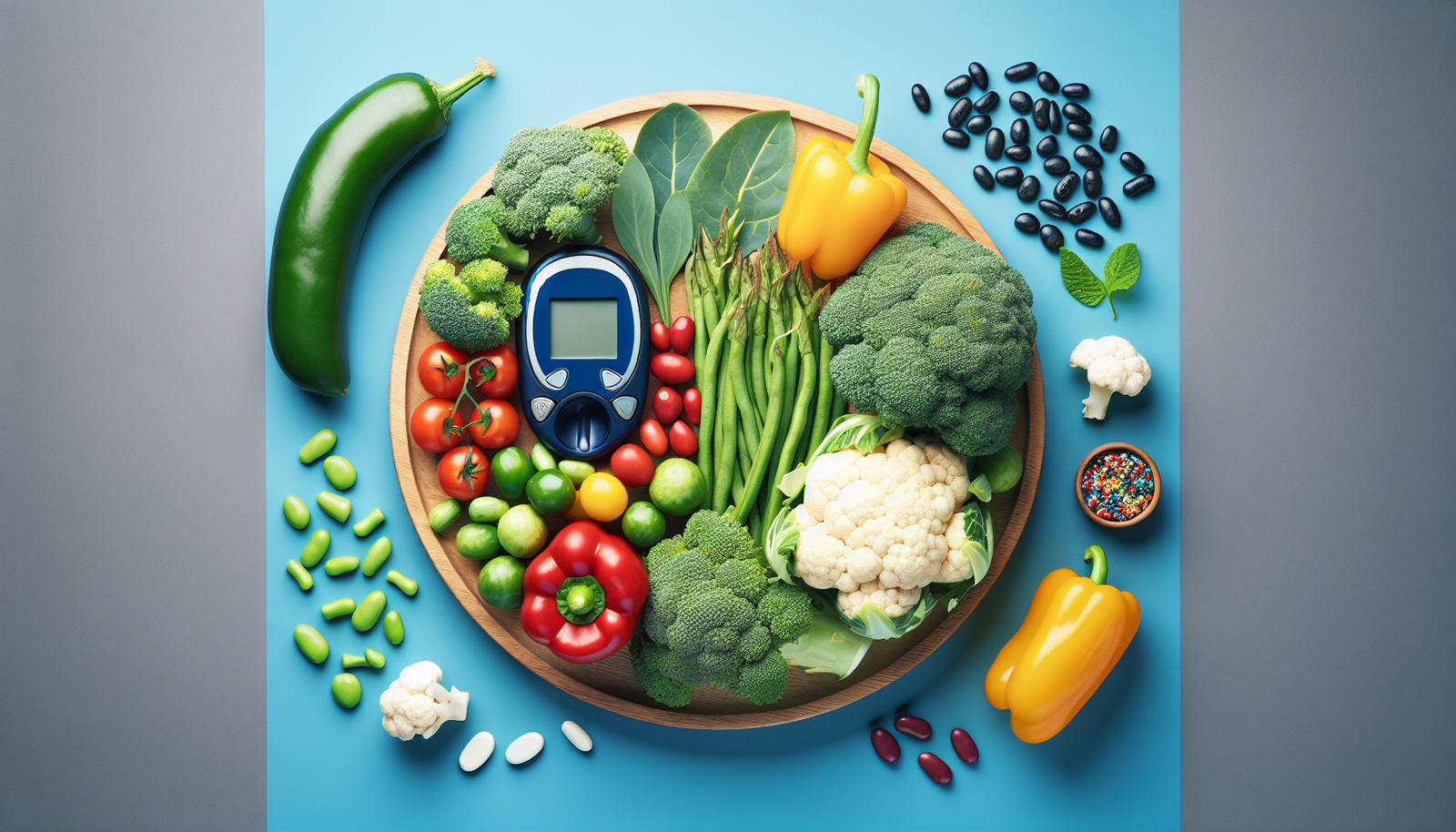Are you looking for natural ways to manage your diabetes? Look no further! This article will introduce you to a variety of vegetables that can play a significant role in controlling your blood sugar levels and overall well-being. By incorporating these powerhouse vegetables into your diet, you can enjoy their delicious flavors while reaping the numerous health benefits they offer. Stick around to explore the world of diabetes-friendly vegetables and take a step towards a healthier lifestyle.
Leafy Green Vegetables
Leafy green vegetables are excellent choices for managing diabetes due to their low glycemic index and high fiber content. Spinach, kale, collard greens, and Swiss chard are all packed with essential nutrients and can be incorporated into your diet in various ways.
Spinach, for instance, can be added to salads, smoothies, omelets, or sautéed as a delicious side dish. Its dark green leaves are rich in vitamins A, C, and K, as well as folate and iron. Kale, another leafy green powerhouse, is known for its high antioxidant content and is particularly beneficial for eye health.
Collard greens, often used in Southern cooking, offer a great source of calcium, vitamin C, and vitamin K. They can be steamed, braised, or added to stews. Swiss chard, with its vibrant colors and mild taste, is an excellent source of vitamins A, C, and K, as well as magnesium. It can be used in stir-fries, soups, or even as a substitute for tortillas in wraps.
Including leafy green vegetables in your diet provides a myriad of health benefits, including improved blood sugar control and reduced risk of chronic diseases.
Cruciferous Vegetables
Cruciferous vegetables, such as Broccoli, cauliflower, cabbage, and Brussels sprouts, are valuable additions for people managing diabetes. These veggies are low in calories and carbohydrates, making them excellent choices for keeping your blood sugar levels stable.
Broccoli, known for its high fiber content and numerous antioxidants, can be enjoyed steamed, roasted, or added to stir-fries and salads. It is a rich source of vitamins C, K, and A, as well as folate. Cauliflower is another versatile vegetable that can be used as a substitute for rice, mashed potatoes, or even pizza crust. It contains compounds that support detoxification and is packed with vitamins C and K.
Cabbage, available in various forms like green, red, or savoy, is an excellent source of vitamin C and fiber. It can be used in coleslaw, stir-fries, or fermented as sauerkraut. Brussels sprouts are often overlooked but are highly nutritious. These tiny cabbages are packed with vitamins C and K, as well as fiber. They can be roasted, sautéed, or even shaved raw into salads.
By incorporating these cruciferous vegetables into your meals, you can take advantage of their health-promoting properties and effectively manage your diabetes.

Allium Vegetables
Allium vegetables, including garlic, onions, leeks, and shallots, are not only flavorful additions to your meals but also offer several health benefits, including blood sugar management. Garlic, known for its distinct taste and aroma, has been found to have antidiabetic effects by improving insulin sensitivity. It can enhance the flavor of various dishes, such as stir-fries and roasted vegetables.
Onions, with their variety of types and flavors, are not only low in calories but also contain compounds that can help lower blood sugar levels. Whether raw in salads or cooked in soups and stews, onions provide a burst of flavor. Leeks, with their mild onion-like taste, are rich in vitamins A, K, and C, as well as fiber. They can be added to recipes like quiches, soups, or stir-fries.
Shallots, often described as a cross between onions and garlic, can add a delicate sweetness to your dishes. They contain antioxidants and compounds that may help improve insulin sensitivity. Shallots are versatile and can be used in dressings, sauces, or sautéed as a topping for meat or vegetables.
By incorporating these allium vegetables into your cooking, you not only enhance the flavors of your meals but also support healthy blood sugar levels.
Root Vegetables
Root vegetables, such as carrots, beets, turnips, and radishes, offer a variety of colors, flavors, and textures while providing numerous health benefits for individuals managing diabetes.
Carrots, known for their bright orange color and sweet taste, are packed with beta-carotene, a precursor to vitamin A. They are also high in fiber, which aids in blood sugar control. Carrots can be enjoyed raw as a snack, roasted as a side dish, or added to soups and stews.
Beets, with their deep red color and earthy flavor, contain antioxidants that help reduce inflammation and improve heart health. They are also a good source of fiber and vitamins C and K. Beets can be roasted, boiled, or pickled for a tangy addition to salads.
Turnips, often overlooked, are low in carbohydrates and calories, making them a great choice for managing blood sugar levels. They can be mashed, roasted, or added to soups and stews for an extra layer of flavor. Radishes, with their crunchy texture and peppery flavor, are low in calories and contain compounds that may help regulate blood sugar levels. They can be enjoyed raw in salads, sautéed, or pickled.
Including root vegetables in your meals adds variety, flavor, and essential nutrients while supporting your diabetes management goals.

Crunchy Vegetables
Crunchy vegetables not only satisfy your appetite but also provide important nutrients and contribute to healthy blood sugar management. Celery, cucumber, bell peppers, and pumpkin are all excellent choices to incorporate into your diet.
Celery, often touted for its low-calorie content, is mainly composed of water and provides a satisfying crunch. It is also a good source of antioxidants, vitamins A and C, and fiber. Celery can be enjoyed raw as a snack or added to salads, stir-fries, or soups for extra texture and flavor.
Cucumbers, with their high water content, are refreshing and hydrating. They are low in calories and carbohydrates, making them an ideal choice for diabetes management. Cucumbers can be sliced and added to salads, pickled, or blended into refreshing smoothies.
Bell peppers, available in various vibrant colors, are not only visually appealing but also rich in vitamins A and C, as well as fiber. They can be enjoyed raw in salads, stuffed with various fillings, or added to stir-fries and fajitas for extra crunch and flavor.
Pumpkin, often associated with fall dishes and holiday recipes, is a nutrient-dense vegetable that is low in calories and packed with vitamins A and C. It can be roasted, pureed for soups, or added to baked goods for a natural sweetness.
Incorporating these crunchy vegetables into your meals provides a satisfying crunch and a range of essential nutrients to support your diabetes management efforts.
Legumes and Beans
Legumes and beans are nutritional powerhouses that offer multiple health benefits, including improved blood sugar control. Lentils, kidney beans, chickpeas, and black beans are all excellent choices for individuals managing diabetes.
Lentils, available in various colors and sizes, are high in both fiber and protein. They have a low glycemic index, meaning they release sugar into the bloodstream at a slower pace, supporting stable blood sugar levels. Lentils can be cooked and added to salads, soups, or stews for a hearty and nutritious meal.
Kidney beans, known for their rich red color and kidney-like shape, are an excellent source of plant-based protein, fiber, and magnesium. They can be added to chili, soups, or salads for extra texture and flavor.
Chickpeas, popular in Mediterranean cuisine, are versatile and can be used to make hummus, added to salads, or roasted for a healthy snack. They are high in fiber and protein, which helps slow down the release of sugar into the bloodstream.
Black beans, often used in Latin American dishes, provide a good source of dietary fiber, protein, and essential minerals. They can be added to soups, stews, or salads for a satisfying and nutrient-dense meal.
By including legumes and beans in your diet, you can benefit from their nutritional profile and their ability to support stable blood sugar control.

Tomatoes
Tomatoes, although technically a fruit, are often categorized as vegetables due to their culinary uses. They are a versatile ingredient that can be enjoyed in various forms, such as sliced tomatoes, cherry tomatoes, sun-dried tomatoes, and tomato sauce, all of which offer different health benefits for individuals managing diabetes.
Sliced tomatoes, whether added to sandwiches, salads, or served as a side dish, are low in calories and carbohydrates while rich in vitamins A and C. They provide a burst of freshness and can be enjoyed in a multitude of savory dishes.
Cherry tomatoes, known for their bite-sized nature and sweeter taste, are perfect for adding to salads, skewers, or enjoyed as a healthy snack. They are rich in vitamins A and C, as well as lycopene, an antioxidant known for its potential role in reducing the risk of chronic diseases.
Sun-dried tomatoes offer a concentrated flavor and are often used in Mediterranean dishes. Although they are higher in calories, they are a good source of vitamins A and K, as well as antioxidants. They can be added to pasta, pizzas, or used to make flavorful spreads.
Tomato sauce, whether homemade or store-bought, can be used as a base for various dishes like pasta, stews, or casseroles. It provides a rich flavor while being low in calories and carbohydrates. When selecting tomato sauce, opt for options with no added sugars or excess sodium.
Incorporating tomatoes into your meals offers a range of vitamins, antioxidants, and unique flavors while supporting your diabetes management goals.
Cucumbers
Cucumbers are not only refreshing but also low in calories and carbohydrates, making them an excellent choice for managing diabetes. They can be enjoyed in salads, pickled, used in smoothies, or even infused in water for a hydrating and flavorful beverage.
Cucumbers in salads add a refreshing crunch and a high water content, which helps promote hydration. They can be sliced, diced, or even spiralized to add texture and volume to your favorite salad recipes.
Pickled cucumbers, often referred to as pickles, are cucumbers that have been fermented in vinegar or brine. They offer a tangy and savory flavor that pairs well with sandwiches, burgers, or can be enjoyed as a snack on their own. However, it is important to opt for low-sodium or homemade pickles to avoid excess salt intake.
Cucumber smoothies are a refreshing way to incorporate this vegetable into your diet. They can be blended with other fruits or vegetables like spinach, lemon, or mint to create a satisfying and nutritious beverage.
Cucumber water, also known as infused water, is a simple yet flavorful way to stay hydrated. By adding thin slices or chunks of cucumber to a pitcher of water, you can enjoy the subtle taste and reap the benefits of staying well-hydrated throughout the day.
Incorporating cucumbers into your diet provides hydration, essential vitamins, and fiber while helping you manage your blood sugar levels effectively.

Bell Peppers
Bell peppers, available in various colors, are not only visually appealing but also offer a range of health benefits. Whether you prefer red, yellow, or green bell peppers, they are all excellent sources of vitamins A and C, fiber, and antioxidants.
Red bell peppers, known for their sweet taste and vibrant color, are the ripest form of bell peppers and pack the highest amount of nutrients. They can be enjoyed raw in salads, grilled, roasted, or incorporated into various dishes for added flavor and crunch.
Yellow bell peppers, slightly sweeter than green bell peppers, provide the same nutritional benefits while adding a pop of color to your meals. They can be stuffed, sautéed, grilled, or used in stir-fries to enhance the taste and presentation.
Green bell peppers, the least ripe form, have a slightly bitter taste and offer a crisp texture. They can be enjoyed raw as a snack or added to stir-fries, fajitas, or frittatas for an added crunch and subtle flavor.
Stuffed bell peppers are a popular dish where bell peppers are filled with a mixture of ingredients like rice, ground meat, or vegetables. They are then baked until tender, creating a flavorful and nutritious meal.
By incorporating bell peppers into your dishes, you not only add vibrant colors but also benefit from their nutritional content and their ability to support your diabetes management goals.
Asparagus
Asparagus, known for its distinctive shape and mild taste, is a nutrient-dense vegetable that can be enjoyed in various ways. Whether steamed, grilled, roasted, or stir-fried, asparagus offers a range of health benefits and adds a delicious twist to any meal.
Steamed asparagus, a simple and quick cooking method, helps retain its vibrant color, crispness, and nutritional value. It can be enjoyed as a side dish, tossed into salads, or even included in pasta dishes for a burst of freshness and texture.
Grilled asparagus takes on a slightly smoky flavor and a tender texture. It can be seasoned with herbs and spices, drizzled with olive oil, and cooked on a grill for a delightful addition to your barbecue or summertime meals.
Roasted asparagus offers a caramelized and slightly crispy texture that enhances its natural flavors. It can be roasted in the oven with a sprinkle of salt, pepper, and olive oil, then served as a side dish or used as a topping for pizzas or salads.
Asparagus stir-fry is a quick and tasty way to enjoy this vegetable. Combined with other colorful vegetables like bell peppers, carrots, or snap peas, asparagus adds a unique texture and taste to stir-fries. It can be paired with lean proteins like chicken or shrimp for a complete and balanced meal.
By incorporating asparagus into your diet, you can enjoy its unique flavor while benefiting from its nutritional profile, which includes vitamins A, C, and K, as well as folate and fiber.
In conclusion, incorporating a variety of vegetables into your diet is essential for managing diabetes. Leafy green vegetables, cruciferous vegetables, allium vegetables, root vegetables, crunchy vegetables, legumes and beans, tomatoes, cucumbers, bell peppers, and asparagus are all excellent choices for individuals seeking to maintain stable blood sugar levels and overall health. Whether enjoyed raw, cooked, steamed, grilled, or roasted, these vegetables offer a wealth of nutrients, flavors, and textures. By making vegetables a central part of your meals, you ensure a nutrient-rich diet that supports your diabetes management goals and overall well-being. So go ahead, get creative in the kitchen, and enjoy the multitude of benefits these vegetables have to offer!


